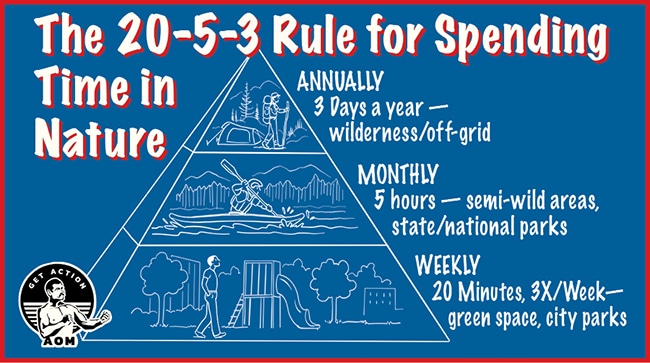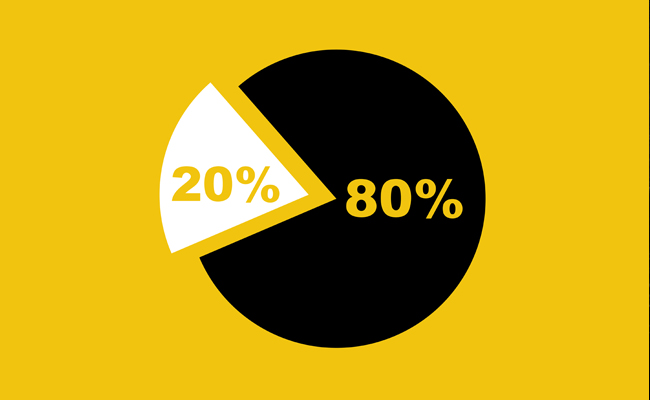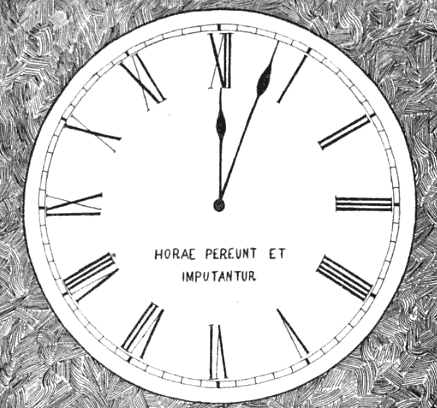
We’re big proponents of getting outdoors here at AoM.
Spending regular time in nature comes with a whole host of benefits. It reduces stress, fights depression, improves focus, and can even speed up recovery from injuries and illness.
Spending time outdoors is also just good for a man’s soul. The wild can induce awe and wonder, which keeps us humble and grounded.
So, how much time in nature do you need to get these benefits?
In The Comfort Crisis, Michael Easter (check out our podcast interview with him about the book) highlighted research from Dr. Rachel Hopman, a professor of psychology at the University of Utah, that provides a prescription for spending time in nature to improve our health and well-being.
Hopman based her prescription on the idea of a “nature pyramid,” first developed by Tanya Denckla Cobb at the University of Virginia. Hopman simplified the nature pyramid idea into an easy-to-remember rule: 20-5-3.
The 20-5-3 Rule for Spending Time in Nature
The 20-5-3 Rule translates into the following guidelines for spending sufficient time in nature:
- 20 minutes in green space, three times a week
- 5 hours in a semi-wild environment, once a month
- 3 days completely off-grid, annually
Let’s delve further into how to fulfill each segment of this formula and the benefits of doing so:
Your Weekly Dose: 20 Minutes X 3
According to Hopman’s research, you can start to get the health-boosting benefits of nature by spending 20 minutes in a green space at least three times a week. These short outdoor jaunts can lower cortisol levels, boost cognition, and improve mental health.
Here’s the good news about this component of the 20-5-3 Rule: your thrice-weekly jaunts in green space don’t have to take place in a wilderness area to reap the benefits. You can spend your 20-minute allotments in any natural environment nearby — a pocket park, a community garden, or even a tree-lined street. So, even if you live in a city, getting in an every-other-day dose of nature is very doable.
That being said, the more leafy and bucolic and the less cement-covered and civilized the setting of your outdoor interludes, the better they’ll make you feel.
Regardless of where you take your thrice-weekly dips into nature, put your smartphone away when you engage in them; Hopman found “that people who used their cell phone on the walk saw none of [the] benefits.”
Use your lunch break for a walk through a local park or stroll around your neighborhood after dinner (the benefits of an after-dinner walk extend beyond the nature exposure!). Make it a daily part of your routine, and start reaping the benefits of vitamin N.
Monthly Immersion: 5 Hours in Semi-Wild Nature
Think of your thrice-weekly 20-minute green space doses as the bottom of the nature pyramid. To start ratcheting up the benefits of nature, Hopman’s research suggests that we should aim to get 5 hours a month in semi-wild nature — a place with minimal urban intrusions. As mentioned above, the wilder the space you spend time in, the greater the effect it has on your health and psyche, so the aim as you move up the nature pyramid is to get a progressively deeper connection with the great outdoors. The higher the level of nature exposure, the happier and less stressed people feel.
To get your more immersive monthly dose of nature, take a hike in a state or national park, spend the day at the beach, or go fishing at a local lake.
Annual Reset: 3 Days Off the Grid
This is the top of the nature pyramid. Once a year, go somewhere off-grid — with few signs of human civilization and hardly any human contact — and spend three solid days there.
Research has shown that spending three days off the grid can relax the brain and boost creativity. Military vets with PTSD who spent four days in the wilds saw a 29% reduction in symptoms.
Spending this much time in the wild is like rebooting your brain to its factory settings.
An annual backpacking trip can get you your yearly three-day nature reset.
You can also do dispersed camping.
If you don’t want to rough it, find a cabin in the woods on VRBO or Airbnb and spend the weekend there. Look for a listing that doesn’t have wifi or cell service. Force yourself to unplug.
The 20-5-3 Rule provides an excellent, motivating rubric for thinking about how much time you need to spend in the great outdoors. But don’t get too hung up on the specific numbers; after all, the last thing you want to do is to turn spending time in nature into another chore to mark off your to-do list. Just remember two overarching principles: 1) the more time you spend in nature, the better, and 2) the wilder the nature, the better. And then just get out there as much as you can!







